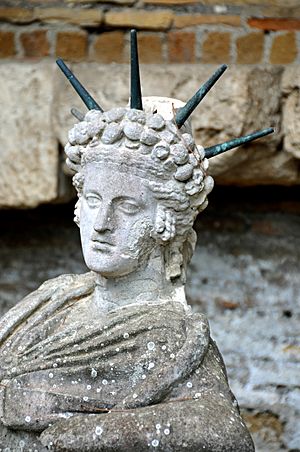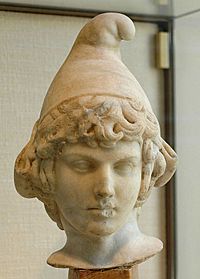Attis facts for kids
In Anatolian mythology, Attis was the eunuch consort of the goddess Cybele. He was the son of Nana, the daughter of the river god Sangarius. Attis died and was resurrected by Cybele. He was a god of vegetation and represented the fruits of the earth, which died in winter and grew back again in the spring. He is often shown wearing a Phrygian cap on his head. The cult of Cybele and Attis was adopted by the Greeks and later by the Romans.
Archaeological finds

The most important representation of Attis is the lifesize statue discovered at Ostia Antica, near the mouth of Rome's river. In his left hand is a shepherd's crook, in his right hand a pomegranate. His head is crowned with a pine garland with fruits, bronze rays of the sun, and on his Phrygian cap is a crescent moon. It was discovered in 1867 at the Campus of the Magna Mater together with other statues. The objects seem to have been hidden there in late antiquity. A plaster cast of it sits in the apse of the Sanctuary of Attis at the Campus of the Magna Mater, while the original was moved to the Vatican Museums.
A marble bas-relief depicting Cybele in her chariot and Attis, from Magna Graecia, is in the archaeological museum in Venice. The pair also feature prominently on the silver Parabiago plate.
A finely executed silvery brass Attis that had been ritually consigned to the Moselle River was recovered during construction in 1963 and is kept at the Rheinisches Landesmuseum of Trier. It shows the typically Anatolian costume of the god: trousers fastened together down the front of the legs with toggles and the Phrygian cap.
In 2007, in the ruins of Herculaneum a wooden throne was discovered adorned with a relief of Attis beneath a sacred pine tree, gathering cones. Various finds suggest that the cult of Attis was popular in Herculaneum at the time of the eruption of Vesuvius in 79 CE.
Images for kids
-
Attis wearing the Phrygian cap. Terracotta thymiaterion at the Louvre from Tarsus
See also
 In Spanish: Atis para niños
In Spanish: Atis para niños





